Sri Lanka Endemic Birds
Sri Lanka Spurfowl Galloperdix bicalcarata
This ultra-elusive endemic is arguably one of the toughest endemics, for it absolutely fears bipeds. Its species name suggests the presence of two spurs, which, incidentally, is not a feature restricted to this species, as the two Indian Spurfowls too bear that. However, this is the only Spurfowl that has a red bill. Its cackling early morning choruses are unmistakable elements of rain forest soundscape. Expert ventriloquists, Sri Lanka Spurfowl often call while moving making it more difficult to track in the dense undergrowth. This endemic was discovered by Joan Gideon Loten, the Dutch governor of Sri Lanka from 1752-1758, who commissioned a Sri Lankan artist of European descent named Pieter Cornelis de Bevere to illustrate it, as he did with all his other specimens. Later on, based on these paintings, in 1781, this bird was named by the famous Johann Reinhold Forster-the man who first elucidated the 'species-area relationship' to the world.
Sri Lanka Junglefowl Gallus lafayettii
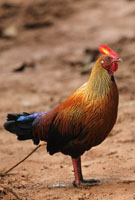
This forest chicken is one of the most widely distributed endemics found in wilderness areas from sea level up to upper-montane forests of Horton Plains National Park 2,100 metres above sea level. Its "chuck-joy joyce" call of the male is cannot be confused with any other bird in Sri Lanka. Sri Lanka Junglefowl was described, half a century after the preceding species, in 1831 by Rene Primevere Lesson. Its species name has been named in honour of Lafayette, a French solider, liberal republican statesman, and hero of the America War of Independence. Sri Lanka Junglefowl is the national bird of Sri Lanka, and two of the best places to it are Sinharaja rain forest is the easiest location to see and photograph it, as most birds there are quite habituated.
Crimson-backed Flameback Chrysocolaptes stricklandi
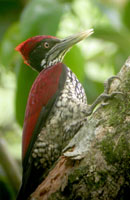
Elevated to the prestigious endemic-club by Rasmussen and Anderton in 2005, this handsome attractive woodpecker is best told apart in Sri Lanka by the strikingly similar Black-rumped Flameback by its ivory coloured bill, whitish iris, "white island" (demacated by black) in the cheek, and distinct high pitched trilling call. Its female, unlike the male shown left, has a black forecrown that is flecked with small white spots ("salt and pepper"). It is found in forests and well-wooded patches close to forests in the wet and dry zone alike. This bird was discovered by Edgar Leopold Layard (1824-1900) who served in the civil service between 1846-1853 and was named in 1849 by Edward Blyth, Curator of the Museum of the Asiatic Society of Bengal in Calcutta.
Yellow-fronted Barbet Megalaima flavifrons
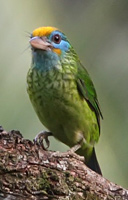
This is one of the common endemics, and its far-reaching calls are a signature feature of the wet zone of Sri Lanka. It is distinguished clearly by other barbets by its golden yellow forehead and light blue face. This is a regular member of the mixed-species bird flocks in the Sinharaja rain forest. Yellow-fronted Barbet was described in 1817 by the renowned French systamatist Baron Georges Curvier, who is more famous for his pioneering work on local freshwater fish.
Sri Lanka Small Barbet Megalaima rubricapillus
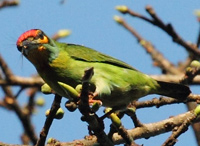
This has made a re-entry to the elite endemic club following Rasmussen and Anderton (2005), after having a few issues over its membership previously! This widely distributed barbet is the only endemic that could be seen in Colombo and suburbs. It could be identified from the similar-looking Coppersmith Barbet by its orange yellow eye-ring and throat (yellow in CB), pale bluish head sides and largely unstreaked green underparts. It was formally described by Johann Friedrich in 1789. Its species name means "red hair" which alludes to its bright, red forehead.
Sri Lanka Grey Hornbill Ocyceros gingalensis
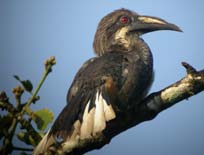
This is the only grey hornbill found in Sri Lanka, which makes its identification easy as A.B.C. It has no casque on the bill. The males could be identified by its cream beak with black base to upper mandible; whereas, the female has a black beak with yellow stripe on the cutting edge of the upper mandible. It is widely distributed in forested habitats up to 1,200 metres above sea level. According to Legge, this was hunted by the natives for flesh, which he described to be "tender and not distasteful." Luckily, this practice is unheard of today. Sri Lanka Grey Hornbill was described by an Englishman named George Shaw in 1811.
Red-faced Malkoha Phaenicophaeus pyrrhocephalus
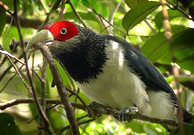
This attractive Malkoha is found in good quality forests in the wet zone and tall riverine forests in the dry zone, where it is under-observed. Sinharaja rainforest is arguably the best place to see it, where it is considered a regular member of the mixed species bird flock having recorded in 48 % of the flocks studied since 1981. It flits in the thick foliage discreetly often melting away, only to rematerialize in another place moments later, making it tough at times to obtain prolonged views. This was described by Thomas Pennant in 1769 through engravings made by de Bevere, after it was discovered by the Dutch Governor Loten. It conservation reads as "vulnerable." To read more about this interesting Malkoha Click here.
Green-billed Coucal Centropus chlororhynchos
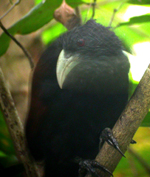
This elusive endemic is a hot favourite in the birder's menu. It is typically found in wet forests with thick undergrowth dominated by bamboo and tree ferns. It also visits well-wooded home gardens that are close to good-quality forests, and may present, not living up to its reputation of being a tough endemic. The bamboo-dominated Bodhinagala forest holds a good population of it, but of the regular birding sites visited by birders, it is easiest to get at Kithulgala. Its characteristic booming call with a sonorous touch is easier to imitate with practice. The Green-billed Coucal was discovered by Layard, and described by Blyth in 1849.
Sri Lanka Hanging Parrot Loriculus beryllinus
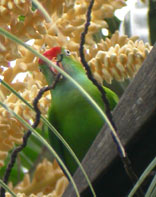
Often seen whizzing past in great speed, this acrobatic endemic is easier to see in well-wooded home gardens, especially those that are near forests. Its species name refers to beryl, a precious stone found in Sri Lanka, which is of sea green colour. Formerly known as Sri Lanka Lorikeet, this endemic is notoriously known to be partial to sweet toddy extracted from coconut, and fish-tail Palms; and its known to become intoxicated, just like some of its local countrymen. This too was described by Johann Reinhold Forster in 1781 though engravings made by de Bevere. Its common name alludes to its peculiar sleeping posture of it like that of a bat.
Layard's Parakeet Psittacula calthropae
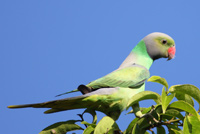
This is distributed in the wet and intermediate zones ascending up to 1700 metres above sea level. It moves about in small flocks, often uttering loud calls. It is occasionally seen joining the mixed-species bird flocks in Sinharaja. Frugivorous and strictly arboreal, Layard's Parakeet has not exploited the abundant cultivation crops available like the widespread Rose-ringed Parakeet. It was discovered by Edgar Leopold Layard and named by Sir Edward Blyth in 1849. The species name, calthropae, eponymously named in honour of Lady Calthrop, Layard's wife.
Serendib Scops Owl Otus thilohoffmanni
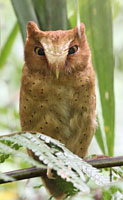
Discovered in 2001 by Deepal Warakogoda, the country's foremost ornithologist, and formally described by Warakogoda and Rasmussen in 2004, this avian jewel is named in honour of Thilo Hoffmann, a top conservationist, who spearheaded a campaign for saving the Sinharaja rain forest from complete logging. It was at Sinharaja that Deepal first laid eyes on it in Jan, 2001, after first hearing it in 1995! It is only known from 5 tracts of lowland rainforests, and its total population is estimated to be 200-250, making it a threatened endemic. Where it is found, Serendib Scops Owl prefers habiatas with closely spaced, dense successional growth dominated by bamboo, and tree ferns. Last endemic species to be discovered before Serendib Scops Owl was Sri Lanka Whistling Thrush, which was found 132 years ago, in the Victorian era of discovery. Serendib Scops Owl is the best thing to happen in Sri Lankan ornithology.
Chestnut-backed Owlet Glaucidium castanonotum
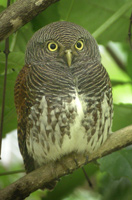
This was the only endemic owl before Serendib Scops Ow entered the scene. It is diurnal in its habits and prefers broad-leaved forest trees, and woody home gardens near them. Spotting one through the chaos of rainforest vegetation, especially at Sinharaja rain forests is tough because of highly stratified nature of this old growth forest. By contast, it is easier at Kithulgala, where there are several stake outs. The picture shown here was digiscoped at point-blank range there in December, 2007. Formally regarded as conspecific with Jungle Owlet or Asian Barred Owlet, it is considered a distinct species based on its morphology and vocalisation. It was discovered by Robert Templeton, an Irish Medical officer with the Royal Artillery, who was stationed in the British Ceylon during 1839-1848. It was escribed formally by Blyth in 1849.
Sri Lanka Wood Pigeon Columba torringtonii
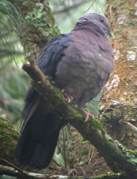
Essentially a montane endemic, this pigeon descends to much lower elevations such as Sinharaja and Kandy in search of their seasonal fruits. Horton Plains, Hakgala, Nuwara Eliya are some of the places to look for it; however, it is by no means common in these areas. This was discovered by Edward Fedric Kelaart (1818-1860), who was a Sri Lankan doctor of Dutch origin, and was named in 1854 by Blyth. Species name honours Torrington, Viscountess, wife of George Byng, Viscount Torrington governor of Ceylon from 1847-1850.
Sri Lanka Green Pigeon Treron pompadora
This widely distributed Green pigeon was formally considered conspecific with Pompadour Green Pigeon, but was elevated to the endemic status by Rasmussen and Anderton in 2005. It is found in good numbers in forested habitats such as Kithulgala, Gilimale and Sinharaja where they are often found engaged in marathon lounging sessions in taller trees. The song is a human like melodious whistle, and is easy to mimick with practice. It was named by Gmelin based on Governor Loten's collections. Known to its wandering qualities, Sri Lanka Green Pigeon can turn up woody gardensin developed areas; it's been seen at Talanagama wetland, and the garden of Taj Airport Garden Hotel close the airport.
Sri Lanka Blue Magpie Urocissa ornata
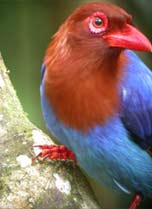
This blue and chestnut knock-out is on the top of every visiting birder's wish list. And why not! It is mostly found in pairs or small groups. Its genus Urocissa shows discontinuous distribution being found in Sri Lanka, absent in south India and found again in Northern India and beyond; thus making an interesting topic for biogeographers. It was named by Johann Georg Wagler in 1829. Its species names means "caparisoned." This handsome corvid is found in the remaining good quality wet zone forests. Sinharaja remains its foremost stronghold. Chaminda Ratnayake-a childhood birding pal of mine- and a amember of the Field Ornithology Group of Sri Lanka has carried out a prolonged single-species study of it. Chaminda discovered many aspects about its ecology including that it is a cooperate breeder. He's also found that like the species below, it is engages in "context-dependent vocal mimicry!"
Sri Lanka Crested Drongo Dicrurus lophorinus
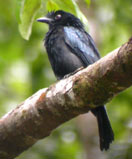
This was spit from Greater Racket-tailed Drongo, and elevated to the exclusive endemic club by Rasmussen and Anderton in 2005, though a formal justification of this treatment is yet to appear. It shows distinct differences in plumage from the former namely short rounded nasal crest and much more deeply forked tail, lacking rackets. Its vocalisations are also distinct and has a wide repertoire of calls. It is a nuclear species of the mixed species bird flock in Sinharaja rainforest found in 89 % of the flocks studied so far second only to Orange-billed Babbler, which has a 92 % presence. It is extremely skilled at mimicry, a skill it uses for good effect to confuse birds and birders.To read more about this interesting Drongo Click here.
Sri Lanka Woodshrike Tephrodornis affinis
Yet another addition to the ever growing endemics tally, this is a rather common resident found mainly in the dry zone. This was formally regarded as conspecific with the Common Woodshrike (T.pondicerianus), but considered a spilt due to the striking differences in plumage features, and vocalisations. It has a dark grey cheek patch bordered by a pale submoustachial below and a weaker eyebrow above. It has a white rump, black uppertail-coverts and tail with white outer tail features. Furthermore it shows strong sexual dimorphism with male being greyish and the female much browner, which is not shown in the Common Woodshrike found outside Sri Lanka. It has a slightly serrated cutting edge in the beak, which it uses to good effect to bite the hands of ringers.
Sri Lanka Whistling Thrush Myophonus blighi
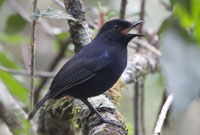
This ultra-secretive endemic is essentially a high-altitude bird found in the cloud forests. A crepuscular bird, it is found mainly in densely wooded ravines and gorges close to streams. It is sexually dimorphic with male appearing blackish blue and the female dark brown. Both show a bright blue shoulder patch though seeing this at poor light can be difficult. This was discovered by Lord Walden and described in 1872 by Edmund Holdsworth, a marine biologist who was in Sri Lanka from 1841-1915. Its species name honours Samuel Bligh a tea planter in Haputale District. Its generic name given by Temminck (1822) comprise myio-a fly- and phoneus-a killer-possibly named in belief that it was a flycatcher. It was the only Sri Lankan endemic listed as endangered by Birdlife International owing to habitat loss, before Serendib Scops Owl entered the scene.
Spot-winged Thrush Zoothera spiloptera
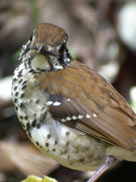
This handsome thrush is found in forests and adjoining well wooded home gardens. It is found from lowlands up to 2100 metres above sea level. It is usually shy during the day, however, turns bold in crepuscular hours, when it is often met on forest footpaths hopping often only a couple of feet away; stopping when you slow down and continuing to walk ahead, as you advance, as if to guide you through the lost trails. It is one of the best songsters of the rainforests in Sri Lanka and Sinharaja rainforest is one of the best places to see it. It was discovered by Templeton and described by Blyth in 1847. To read more about this interesting Thrush Click here.
Sri Lanka Scaly Thrush Zoothera imbricata
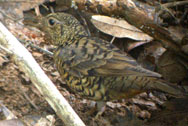
Yet another species formally regarded as endemic by Legge but later regarded as conspecific with Z. dauma. It has been elevated into endemic status by Rasmussen and Anderton in 2005 based on its distinct plumage and vocalisation. This shy forest dweller has an diferrent profile compared with the preceeding species, and unlike it, prefers to walk than hop. To find food, it uses its very long bill to good effect vigorously moving the leaf litter. This was originally collected by Thwaites and described by Layard in 1854 as an endemic.
Dull-blue Flycatcher Eumyias sordida

This is essentially montane bird is greyish blue overall with a brighter blue forehead. It was formally described by Viscount Arthur Walden in 1870. Its species name means "sordid"-a rude scientific insult! It can bee seen in high elevation forests and well wooded gardens. Horton Plains, Nuwara Eliya, Peak Wilderness and Hakgala Botanical Gardens are some of the good places for this endemic.
White-faced Starling Sturnus albofrontata
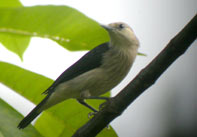
This a regular member of the mixed-species bird flocks in Sinharaja, which is one of its strongholds, together with Peak Wilderness Sanctuary. It is often found in the canopy level, where it perches on dead branches, lanky Alstonia trees, and rattan fronds to offer scope views. This was yet another endemic species discovered in 1854 by Edgar Leopold Layard in his 8 year residence in the island. This is listed as vulnerable by Birdlife International.
Sri Lanka Myna Gracula ptilogenys
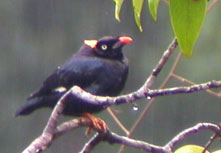
Essentially a canopy bird found in broad-leaved forests up to 2000 meters above sea level, Sri Lanka Myna is mainly identifiable from Lesser Hill Myna by the lack of facial and crown wattles and bearing only a single pair of wattles on its nape. Their far-carrying shrilling calls are unmistakable, and could often be heard in flight over the dense forest canopy. The species name ptilogenys is of Greek origin and is made out of ptilon meaning feather and genyos meaning cheek, which refers to its completely feathered face. This endemic was discovered by Templeton and named by Blyth.
Sri Lanka Swallow Hirundo hyperythra
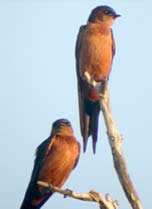
Formally considered conspecific with Red-rumped Swallow, Sri Lanka Swallow was elevated as an endemic by Rasmussen and Anderton in 2005, due to its distinct plumage and vocalisations. It is similar to Red-rumped Swallow but it is darker overall with unstreaked dark rufous underparts and rump and bears short tail streamers. Its got a characteristic musical call. It was discovered by Layard in 1849 and described by Blyth who considered it an endemic.
Black-capped Bulbul Pycnonotus melanicterus
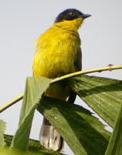
This is yet another species that has made a re-entry to the endemic-club following the recent taxonomic evaluation by Rasmussen and Anderton 2005. It was originally described by Johann Friedrich Gmelin in 1789 based on collections made by Governor Loten, and was considered an endemic then. It occurs in pairs or groups and at times can be seen hovering while foraging. The species name is of Greek origin and is made out of melanos meaning black, which refers to its head and ikteros meaning jaundice which refers to its overall yellowy body. It is a rather common endemic in the wet and dry zone forests.
Yellow-eared Bulbul Pycnonotus penicillatus
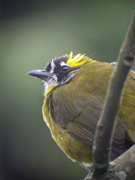
This common montane endemic is often found in pairs or small flocks. Its species name refers to its yellow tuft over the ear, which gives it a handsome look. It could be easily seen in home gardens and as well as forests around Nuwara Eliya. This was discovered by Kelaart and named by Blyth in 1851.
Sri Lanka White-eye Zosterops ceylonensis
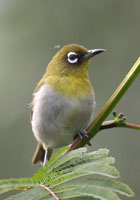
This is the commonest montane endemic, and is often found in groups found in home gardens and forests alike. It is distinctly darker overall compared to the Oriental White-eye. This was discovered by Lord Walden and named by Holdsworth in 1872. Its species name is the Latin rendering of the island's British Colonial name Ceylon. You can see this in forests and gardens around Nuwara Eliya, without going into too much pain. It can also be seen at lowland reaches of sinharaja, where it is not as numerous as in highlands.
Sri Lanka Bush Warbler Elaphrornis palliseri

This is elusive montane endemic is confined to forests with dense undergrowth. It skulks cleverly quite low down. It has been placed on a genus on its own by Rasmussen and Anderton (2005), considering its strongly distinct morphology and vocalisation compared to all Asian Bush Warblers. The species is named after Cecil Palliser, a coffee planter in the 19th century. This was discovered by Kelaart and named by Blyth in 1852.
Ashy-headed Laughingthrush Garrulax cinereifrons
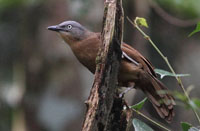
A regular member of the mixed-species bird flocks of Sinharaja, this is the only laughingthrush found in Sri Lanka. Its species name is made out of cineris meaning ashes and frons meaning fore-parts. This was discovered by Kelaart and named by Blyth in 1852. It is considered as vulnerable by Birdlife International.
A nest of this was found in Sinharaja rain forest in November, 2010; and was photographed with a brooding adult bird.
Brown-capped Babbler Pellorneum fuscocapillum
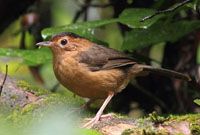
This widely distributed endemic is usually found in territorial pairs in the wet and dry zone forested habitats. Its "pretty-dear" sounding call is characteristic and enables to locate it in the undergrowth. Sigiriya, Kithulgala and Sinharaja are some of the better places to see this endemic Babbler. It occurs in three sub-species within Sri Lanka with the wet zone forms show here appearing darker than the dry zone one. This was discovered by Layard and was described by Blyth in 1849.
Sri Lanka Scimitar Babbler Pomatorhinus melanurus
Formerly considered conspecific with Indian Scimitar Babbler, this is yet another addition to the ever increasing tally of endemic birds in Sri Lanka. It is smaller than it and has rich rufescent-brown upperparts and flanks. Their resonant calls are unmistakable and the pairs utter duets, which are wonderful to listen to. Sri Lanka Scimitar Babbler can be found joining the mixed-species bird flocks in Sinharaja probing tree trunks with their uniquely shaped bill. A pair of these babblers were observed while foraging in the pioneer Macaranga indica in Sep., 2010, during a Field Ornithological Group of Sri Lanka, which is interesting as it is deemed to be a mainly insectivorous bird. This endemic was discovered by Templeton and named by Blyth.
Orange-billed Babbler Turdoides rufescens
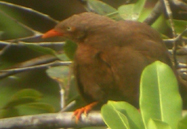
This is one of the two nuclear members of the mixed-species bird flocks studied at Sinharaja being present in 92 % of the flocks studied so far. Highly gregarious, it occurs in flocks averaging 16 and is mainly responsible for the high bird numbers in the flock, which average 42 individuals. It is entirely restricted to the wet zone forests and well wooded habitats and occupies from the under storey up to the canopy. It's characteristic chattering often help to locate the presence of mixed species bird flocks at Sinharaja. This was discovered by Templeton and named by Blyth in 1847.
Legge's Flowerpecker Dicaeum vincens
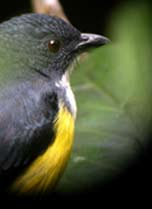
This diminutive endemic is essentially a lowland rainforest specialty. It was described by Phillip Lutley Sclater in 1872 through a specimen collected in 1871 by William Vincent Legge, officer in the Royal Artillery between 1868-1877 and named in honour of legge whose magnum opus "A History of Birds of Ceylon" is still a valuable source of reference on Sri Lankan ornithology. Legge's Flowerpecker prefers top most levels of the forest but also descend quite low down to feed on the fruits of the invasive pioneer shrub Clidemia hirta along forest trails in Sinharaja affording eye-ball views.
The males of this flowerpecker sports blue, white and gold-colours of St. Peter's College, Colombo-Champions in school's Rugby in Sri Lanka!